

Moving Boxes and Supplies
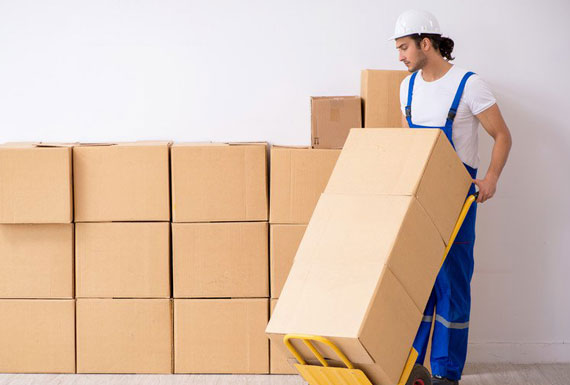
Moving Boxes and Supplies
How Many Moving Boxes Do I Need To Move?
Moving boxes & supplies are important factors to get right when moving. They help you to be prepared and organized for your move. For your convenience, we deliver these tools to your doorstep on the move date.
Types of Moving Boxes & Supplies
- Moving Boxes
- Moving Blankets
- Moving Pads
- Moving Supplies
- Specialty Boxes
- Custom Crating (single shipment crates & multi-use travel crates)
- Moving Kits
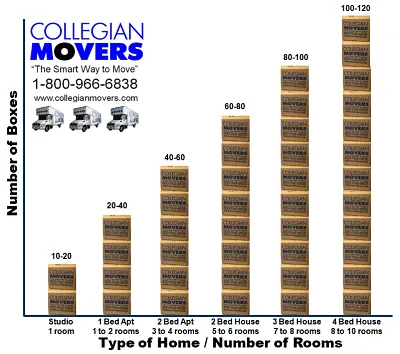
How Many Boxes Are Needed for Each Room?
Moving Supplies
Gather your moving tools ahead of time, makings you feel better equipped for the task of packing. For your convenience, you can order your moving supplies directly from Collegian Movers. Our moving professionals help you to determine the correct types and amounts of moving boxes you need for your upcoming move. These items are an important part of your move to get you prepared and to keep your belongings protected throughout the moving process.
Moving Box Calculator | Packing Supplies Calculator
Step 1: Use the size of your home, the number of people living in it, the belongings you have, plus any special requirements for packing fragile or valuable items to help determine the number of boxes you need to move.
Step 2: Calculate a quick estimate by multiplying the number of rooms in your home by 12.
The moving box calculation uses the assumption, that it takes 10 to 15 boxes to pack one room.
However, please note that this is a general guideline and may not apply to all situations. To provide a more accurate estimation, you can consider the specific size and layout of your rooms. Keep in mind that larger rooms may require more boxes, while smaller ones may need fewer. Additionally, if you have more belongings or if you prefer to pack items more securely, you might need more boxes than the average estimate suggests.
How many boxes should be bought initially for an apartment or single-family home?
If you're wondering how many boxes to buy initially for your apartment or single-family home, let's break it down. For apartment dwellers, it's recommended to start with as few as 20 or 40 boxes. This initial number should be sufficient for most apartment-sized moving endeavors. However, if you reside in a single-family home, it's advisable to purchase at least 40 to 60 boxes before embarking on your packing journey. Keep in mind that every home is different, and you may require more boxes as you progress.
Moving Box Sets
When it comes to residential moving a variety of boxes are needed, including small, medium, and large boxes. In order to properly pack your household, you will also need a variety of different shaped boxes such as dish packs, wardrobe boxes, and file boxes. Next, you should consider the types of items you are moving and the quantity of each item. For example, if you have more clothes or more dishes to pack than an average person, adjust your box order to fit your needs.
Box Guideline (Box Types for Residential Moves)
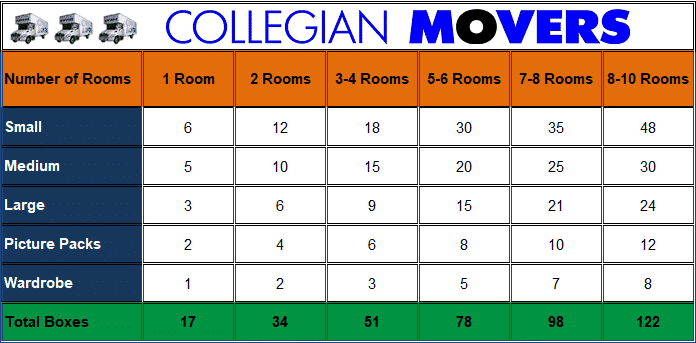
Who Should Pack My Boxes?
When moving companies refer to packing services, they mean the physical wrapping of a household and personal item, and the placing of it into a box. Who packs your boxes will depend upon which packing services choose.
On-Site Packing Services For Local and Long Distance Moves
When packing your belongings for a cross country move, consider hiring professional packers. They will assure you are using the proper packing supplies and moving boxes to minimize damage to your items. Transporting furniture and belongings across states lines requires more care and effort than moving to the other side of town. Your items often have to endure hours of bumpy roads. Items that are not packed properly may shift during transport. Our packing services help to keep your memories safe, so nothing gets accidentally damaged.
Packing & Unpacking Services
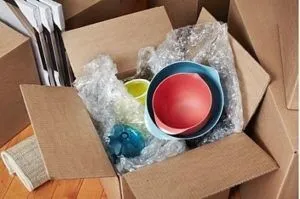
Full-service packing option. Hire our professional movers and packers to pack your entire home or office. This is the fastest option to move out of a home or place of business. It removes the emotional aspect of packing. We assure your items are packed safely, secure, and handled with care. With this option, you have an entire team of packers dedicated to packing your home.
Partial-packing option. Hire our professional packers to help you pack your entire home. We will only pack the items or the rooms that you specify. This speeds up the process to complete the task. It costs less than full-service because it takes less time when you are one of the helpers. We highly recommend that you have Collegian Movers trained packers take care of your fragile items. Packing done by professional packers assures your items arrive at your new location in one piece.
Single-item packing option. We offer single-item specialized packing services, to help protect your most valued possessions. Our movers and packers receive extensive training on how to build high-quality custom crates. They know how to properly pack, wrap, and protect your fragile, delicate, and priceless items to assure they are safe and secure during transport.
Pack your own boxes. This is also referred to as “Packed by Owner” (PBO). This option means that you will be doing all of the packings. On move day, everything is already packed, sealed in boxes and ready to go. The movers collect your boxes, furniture, and other items and load them on the moving truck. They do not pack any of your items.
Unpacking service option. We also offer unpacking services, if needed at your final destination.
Should I Buy Extra Boxes?
Collegian Movers has been moving Connecticut residences since 1989. As a guideline, we always ask our clients, “How long have you lived in your home?” We know that the number of boxes you need to move increases with the number of years you have lived in your home. As the late George Carlin said, most people accumulate lots of “Stuff” over time. So, don’t be surprised when you need more boxes, than the average move.
Have you lived in your home for over 10 years? If yes, you should increase the number of boxes to 12-15 per room, versus the 10 to 12 per average move. Please plan accordingly and note that you are not alone. Most people underestimate the number of boxes they need when planning a move.
Are you downsizing your home? If so, you should focus your efforts on minimizing what you are moving. Donate items, have a garage sale or give things away. The fewer items you have to move, the fewer number of boxes you need.
Moving Boxes in a Variety of Sizes
Most Connecticut Moving Companies recommend purchasing boxes in a variety of sizes. The items you are moving come in many different shapes, sizes, and weights. Each item will not fit in the same size box. As a general rule, when packing boxes heavy items should be packed in small boxes and light items should be packed in large boxes.
Moving boxes are specially designed and manufactured for moving. For example, a dish barrel box (China Box) is extremely sturdy because of its double-walled construction. In general, moving boxes are known to endure a greater load, than the boxes sold by the "big box" stores.
The moving boxes sold and used at Collegian Movers have a 32 Edge Crush Test (E.C.T.) rating or higher. The E.C.T. is a test method used to measure the durability and strength of a moving box. Moving boxes are worth the extra money because of their strength and durability and add extra protection for your items during transport.
We Sell Moving Boxes and Moving Supplies
Our boxes come in many sizes. However, the following types of boxes are the most commonly used by professional moving companies. If you want to be 100% safe with your choice of boxes, you'll want to stock up on some of these quality moving boxes.
Choosing the Right Packing Supplies
Below is a guide for which boxes to use based on the item you are moving. Each box size has specific measurements. The description includes names, sizes, and basic uses. If you need further information on boxes, please contact our sales office. Standard moving boxes come in a variety of sizes: small (1.5 cubic feet), medium (3 cubic feet), large (4.5 cubic feet), extra-large (6 cubic feet), and specialty boxes like dish-packs (about 5.2 cubic feet), wardrobes (10.5 to 16 cubic feet), and mirror cartons (various sizes).
Small Box (Book Carton) - 1.5 cubic feet
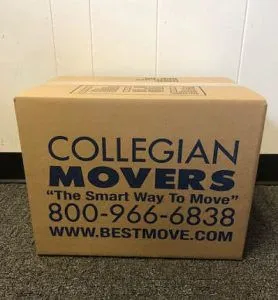
Small boxes are commonly used for papers, magazines, records, CDs, tools, canned goods, and other heavy items, etc. Our book carton boxes are small in size and are easy to handle.
Medium Moving Boxes - 3 cubic feet
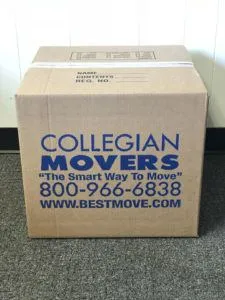
Medium moving boxes are designed to hold the majority of household items. These boxes are durable. They are versatile and suitable for shoes, t-shirts, linens, kitchen items, and sporting goods. Large boxes are often used for bed pillows, comforters, sweaters, bulky holiday decorations, and plastic toys.
Large Moving Boxes - 4.5 cubic feet
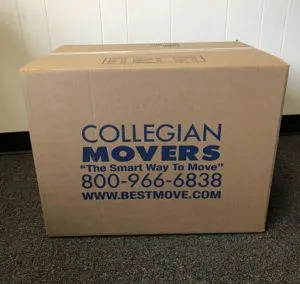
Large boxes are used for light items. Be sure to keep the weight of your boxes reasonable. You don’t want them to become too heavy to carry. Large boxes are used to move items such as speakers, pillows, blankets, bedding, curtains, linens, stuffed animals, and clothing.
China Box (“Dish Barrel”) 5.2 cubic feet
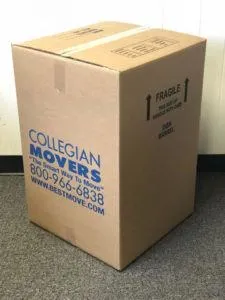
These extra-large boxes are frequently used by movers, while dish-packs are ideal for breakable items like dishes, glassware, and small appliances. These corrugated cartons are commonly used for packing the kitchen and dining room. We suggest you also have bubble wrap and packing paper on hand for this job. By protecting your dishes in bubble wrap or with crushed paper you add an extra level of cushioning to your fragile items. It also helps to eliminate the shifting of items inside these heavy-duty moving boxes.
Our warehouse can be used to store business records, overflow inventory, seasonal items, files, unused furniture, and more.
Tips on How to Pack Dishes in a China Box
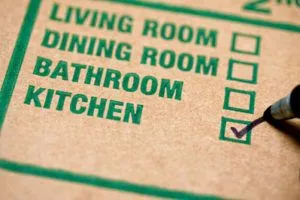
It may not seem like common sense, but when packing a China box, it is a best practice to pack the dishes vertically. Dishes have more strength on their side than when stacked horizontally or flat. So, don’t stack them on top of one another, from the bottom of the box. Place your dishes in a vertical direction. This increases your chances for a smooth move without damage. In addition, for extra protection before placing dishes in the box, place a layer of balled up packing paper on the bottom of the box.
Wardrobe Box - 2 linear feet
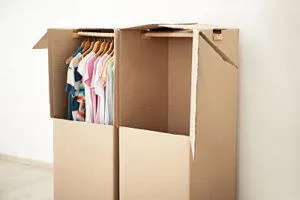
Wardrobe boxes are designed to move and store hanging clothing. In particular, they should be used for items that cannot be folded and packed into a large box. Each wardrobe carton includes a 24-inch bar to accommodate up to 2 linear feet of items. To calculate the number of wardrobe boxes you need, measure the total feet of the hanging bars you use. Every two feet is equal to one box. In addition to the bar, there is plenty of space at the bottom of each box for your shoes and belts or other lightweight items you store in your closet. Special considerations: For wardrobe boxes, it is advised to fasten hangers to the bar using twine or moving tape to prevent hangers from bouncing off during long-distance moves.
Picture / Mirror Carton (Adjustable 4 Picture/Mirror Boxes)
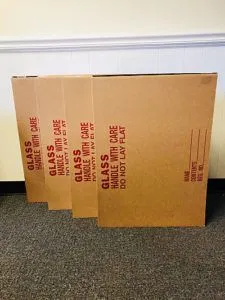
Safely transporting mirrors, pictures, glass tabletops, oversized breakable items, and televisions. Mirror carton boxes are ideal for this type of work. Mirror cartons should be loaded upright in the truck to prevent damage to flat, oversized, breakable items. These boxes come in 4 pieces. The overlapping pieces adjust to allow for a wide variety of sizes and uses. The pieces provide exceptional protection. Special considerations: When packing breakable items in mirror cartons it is recommended to wrap each item with packing paper or bubble wrap, a large paper pad, a moving blanket, or an old sheet before placing it in the box, for extra protection. This cushioning also limits movement during transport.
Mattress Carton
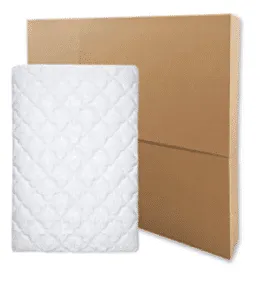
At 8 hours a night, the average person sleeps for one- third of their life. So, it makes sense to protect your mattress during your move. Mattress boxes provide a layer of protection from anything that your bed may be exposed to during transportation. This type of box is available in king, queen, double, single (twin) bed sizes. We recommend you use one for each box spring and the mattress that you are moving.
Packing Materials for Moving
We also offer packing materials you may need for your move, including:
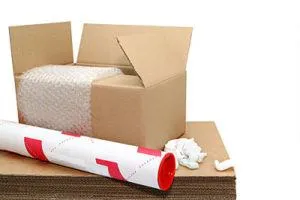
- Boxes
- Packing tape
- Packing pads and covers
- Permanent markers for labeling boxes
- Moving Box Labels (Printable)
- Custom crates and containers
- Strapping
- Protective Packaging Materials and Packing Materials
- Bubble wrap
- Packing paper
- Moving plastic wrap - good for large furniture (sofa, overstuffed chairs, etc.)
- Packing peanuts
Save on Moving Supplies & Boxes
When it comes to moving to a new home or storage unit, saving money and reducing clutter are two key goals. One way to achieve both is by downsizing your belongings. It's surprising how much we accumulate over time, and sorting through closets, attics, basements, or garages can unearth a multitude of items we no longer need or use.
Remember, when you move locally, you pay by the hour, which means you're paying to move every item from one location to the next. By decluttering before the move, you can significantly reduce the number of items you need to pack and transport. This not only saves you time but also cuts down on moving costs.
Consider donating outdated clothing, hosting a tag sale, giving away old toys, or even selling unwanted items online through platforms like eBay. By parting ways with these unnecessary belongings, you'll be lightening the load and ultimately spending less on moving boxes and supplies. The fewer boxes you fill, the greater savings you will experience.
In addition to downsizing, another practical strategy to save money and reduce clutter while packing is to buy your packing materials in stages. Instead of rushing to purchase boxes, paper, and packing tape all at once, start buying them gradually, ideally 4 to 6 weeks before your move. This approach allows you to better estimate the exact amount of materials you'll need, preventing overbuying and unnecessary expenses. Plus, buying in stages ensures that your home remains organized and clutter-free during the packing process.
So, while decluttering helps you cut down on the number of items to move, buying packing materials in stages allows you to optimize your spending and keep your space tidy. By combining these two strategies, you'll not only save money but also create a more seamless and efficient moving experience.
Frequently Asked Questions (FAQs)
How long does it take to pack a 3-bedroom house?
Packing a 3-bedroom house can take varying amounts of time depending on several factors. If you hire professional moving crews, they can typically complete the packing process within a day. However, for individuals who have jobs and families to attend to, the task may take several weeks to accomplish. To ensure a smooth and stress-free packing experience, it is advisable to plan ahead and start the packing process as early as possible.
How many boxes are needed for a kitchen, living room, dining room, master bedroom, spare and children's bedrooms, bathrooms, and other areas?
To ensure a smooth packing process, here is a guideline on the number of boxes typically required for each area of the house:
1. Kitchen:
- Small cartons: 4 to 8
- Medium cartons: 4 to 8
- Large boxes: 3 to 6
- Dish boxes: 3 to 7
2. Living room:
- Small boxes: 3 to 5
- Medium boxes: 3 to 10
- Large boxes: 1 or 2
- Dish boxes for lamps, clocks, and electronics: 2 to 4
- Mirror cartons: 4 to 6
3. Dining room:
- Small boxes: 2 to 4
- Medium boxes: 2 or 3
- Large boxes: 1 or 2
- Dish cartons: 3 to 8
- Mirror carton: 2 to 5
4. Master bedroom:
- Small boxes: 4 to 8
- Medium boxes: 5 to 10
- Large boxes: 4 to 9
- Dish cartons: 2 to 5
- Mirror cartons: 3 to 6
- Wardrobes: 4 to 8
5. Spare and children's bedrooms:
- Small boxes: 2 to 5
- Medium boxes: 3 to 8
- Large boxes: 3 to 6
- Dish cartons: 1 or 2
- Mirror cartons: 1 or 2
- Wardrobes: 2 or 3
6. Bathrooms:
- Small boxes: 2 to 5
- Medium boxes: 2 or 3
7. Other areas (attics, garages, sheds, basements):
- Since these areas vary greatly, it's recommended to allocate more time and use more packing materials than initially estimated.
- Remember, these are general estimates, and your specific needs may vary. It's always a good idea to assess your belongings and adjust accordingly.
How many boxes are needed for each room in a home?
The number of boxes needed for each room in a home can vary depending on the size of the space and the amount of belongings to be packed. Here is a general guideline for estimating the number of boxes required for each room:
1. Kitchen: On average, you may need about 4 to 8 small cartons, 4 to 8 medium cartons, 3 to 6 large boxes, and 3 to 7 dish boxes.
2. Living Room: Typically, you might use 3 to 5 small boxes, 3 to 10 medium boxes, 1 or 2 large boxes, 2 to 4 dish boxes for lamps, clocks, and electronics, and 4 to 6 mirror cartons.
3. Dining Room: For the dining room, you'll generally need 2 to 4 small boxes, 2 or 3 medium boxes, 1 or 2 large boxes, 3 to 8 dish cartons, and 2 to 5 mirror cartons.
4. Master Bedroom: The master bedroom often requires the most boxes. Plan for 4 to 8 small boxes, 5 to 10 medium boxes, 4 to 9 large boxes, 2 to 5 dish cartons, 3 to 6 mirror cartons, and 4 to 8 wardrobes.
5. Spare and Children's Bedrooms: These rooms usually need about 2 to 5 small boxes, 3 to 8 medium boxes, 3 to 6 large boxes, 1 or 2 dish cartons, 1 or 2 mirror cartons, and 2 or 3 wardrobes.
6. Bathrooms: Bathrooms typically require 2 to 5 small boxes and 2 or 3 medium boxes.
For areas such as attics, garages, sheds, and basements, the number of boxes needed can vary greatly. Therefore, it is advisable to allocate more time and packing materials for these spaces.
Keep in mind that these estimates are general guidelines, and the actual number of boxes needed may vary based on individual circumstances. It is important to adjust the carton count as you begin packing to ensure all belongings are safely accommodated.
How many boxes will I need for different sizes of homes and apartments?
To estimate the number of boxes you will need for your move, please refer to the table below. Keep in mind that these numbers are based on moderately furnished homes and apartments of various sizes and number of bedrooms. Additional packing material may be required for spaces such as attics, garages, basements, and sheds. Please use caution as the actual number of boxes may vary.
Home/Apartment Size:
- Small (Studio, 1-bedroom apt.):
- Book box (1.5 cubic feet): 10 boxes
- Medium box (3.0 cubic feet): 14 boxes
- Large box (4.5 cubic feet): 7 boxes
- Dish carton (5.2 cubic feet): 4 boxes
- Wardrobe carton: 2 boxes
- Mirror carton: 5 boxes
- Medium (2 or 3-bedroom apt.):
- Book box (1.5 cubic feet): 14 boxes
- Medium box (3.0 cubic feet): 18 boxes
- Large box (4.5 cubic feet): 11 boxes
- Dish carton (5.2 cubic feet): 6 boxes
- Wardrobe carton: 4 boxes
- Mirror carton: 8 boxes
- Large (2-bedroom home):
- Book box (1.5 cubic feet): 22 boxes
- Medium box (3.0 cubic feet): 28 boxes
- Large box (4.5 cubic feet): 17 boxes
- Dish carton (5.2 cubic feet): 11 boxes
- Wardrobe carton: 6 boxes
- Mirror carton: 12 boxes
- Extra Large (3-bedroom home):
- Book box (1.5 cubic feet): 31 boxes
- Medium box (3.0 cubic feet): 40 boxes
- Large box (4.5 cubic feet): 25 boxes
- Dish carton (5.2 cubic feet): 13 boxes
- Wardrobe carton: 9 boxes
- Mirror carton: 16 boxes
- Extra Large (4-bedroom home):
- Book box (1.5 cubic feet): 42 boxes
- Medium box (3.0 cubic feet): 50 boxes
- Large box (4.5 cubic feet): 34 boxes
- Dish carton (5.2 cubic feet): 18 boxes
- Wardrobe carton: 11 boxes
- Mirror carton: 20 boxes
- Extra Large (5-bedroom home):
- Book box (1.5 cubic feet): 53 boxes
- Medium box (3.0 cubic feet): 66 boxes
- Large box (4.5 cubic feet): 42 boxes
- Dish carton (5.2 cubic feet): 23 boxes
- Wardrobe carton: 14 boxes
- Mirror carton: 25 boxes
Please consider these estimates as a rough guide, and adjust accordingly to ensure you have sufficient boxes for your specific belongings.
Where can I find moving boxes?
There are several places where you can find moving boxes:
1. Grocery stores: Many grocery stores receive regular shipments of products in sturdy boxes. Ask the store manager if they have any boxes available for free.
2. Liquor stores: Liquor boxes are usually strong and durable, perfect for moving. Visit your local liquor store and inquire if they have any empty boxes they can give away.
3. Community recycling centers: Check with your local recycling center or waste management facility. They often have a dedicated area where people can drop off unwanted boxes, which you can pick up for free.
4. Online classifieds: Platforms such as Craigslist or Freecycle often have listings of people giving away moving boxes. Keep an eye on these websites, as free moving boxes are regularly posted.
5. Friends and family: Reach out to your friends, family, or coworkers who have recently moved. They may have extra boxes they no longer need and would be happy to pass them on to you.
6. Retail stores: Large retail stores, especially those selling electronics, furniture, or appliances, receive shipments in sturdy boxes. Call or visit these stores and ask if they have any boxes they are willing to give away.
7. Bookstores: Bookstores typically have strong boxes used to transport books. Ask if they have any available or if they can set some aside for you.
Remember, always check the condition of the boxes and ensure they are suitable for moving. Some essential factors to consider are the size, sturdiness, and cleanliness of the boxes.
Should I hire professional movers or pack boxes myself?
When deciding whether to hire professional movers or pack boxes yourself, there are several factors to consider. If you prioritize safety, convenience, and want to ensure the overall value of your move, it is generally recommended to hire professional movers for the packing process. They have expertise in handling fragile items and can efficiently organize and secure your belongings.
However, if you are on a tight budget and hiring a full-service moving company is not feasible, then packing boxes yourself can help save money. It is important to note that this option requires a significant amount of time and energy. You will need to dedicate time for sorting, organizing, and properly packing your belongings to avoid any damages during the move.
By packing boxes yourself, you have control over how your items are packed, and you can pack them according to your preference. This allows you to personalize the packing process and ensure that your most valuable or delicate possessions are handled with utmost care. It also provides an opportunity to declutter and get rid of items you no longer need, minimizing the packing workload.
However, it is essential to keep in mind that professional movers have experience and expertise when it comes to packing. They are well-versed in using appropriate packing materials and techniques to ensure the safety of your belongings. They also have access to specialized tools and equipment, which can be especially helpful for packing bulky or fragile items.
Ultimately, the decision to hire professional movers or pack boxes yourself depends on your priorities, budget, and the complexity of your move. If you have the resources and want a hassle-free experience, professional movers are your best bet. On the other hand, if you are willing to invest time and effort to save money, self-packing can be a viable option.
What factors determine the number of boxes needed for a move?
The number of boxes required for a move depends on several factors. To determine how many boxes you'll need, consider the amount of possessions you have and the size of the items that will be moved. Generally, the quantity of cardboard boxes can range anywhere between 25 and 250.
It's important to take into account any additional spaces in your home, such as attics, garages, basements, and sheds. These areas may require extra packing materials, which will influence the total number of boxes needed. Likewise, the specific items you own, their dimensions, and how well you pack them can also affect the quantity of boxes required.
However, it is crucial to remember that these numbers are not fixed and should be used as an estimate. Each moving situation is unique, and factors like the shape and fragility of your belongings, the efficiency of your packing techniques, and the layout of your current and future living spaces can all impact the final count of boxes. Therefore, it's always wise to approach these estimates with caution, as the actual number of boxes required for your move could be more or less than anticipated.
How many boxes do I need to move?
Determining the exact number of boxes required to facilitate your move is contingent upon various factors. Instead of offering a single definitive number, it is more helpful to consider a range based on the amount of possessions you possess and the quantity of items you are intending to move. Depending on these variables, you could find yourself needing anywhere between 25 and 250 cardboard boxes. While this wide range may seem unhelpful at first, fear not, as we will delve into each element in detail to provide you with a comprehensive understanding of the factors influencing the number of boxes required for your move. By considering the specific criteria of your situation, we will be able to offer you more precise guidance.
What sets Collegian Movers apart from other moving competitors?
At Collegian Movers, we distinguish ourselves from other moving competitors through our unwavering commitment to providing exceptional customer service. We prioritize your satisfaction above all else and aim to make your entire moving experience stress-free. Our team is well aware of the challenges and complexities associated with relocation, and we go above and beyond to ensure that your transition is smooth and efficient.
Dedication to Quality: What sets us apart is our dedication to quality. From the moment you reach out to us, you will notice the difference in the level of care and attention we provide. Our skilled and dedicated team of movers are trained professionals who are passionate about their work. They are equipped with the expertise to handle your possessions with care and precision, ensuring they are delivered safely to your new home.
Full-Service Approach: We take pride in our full-service approach, offering a comprehensive range of moving services tailored to meet your unique needs. Whether you require packing assistance, secure storage solutions, or transportation logistics, we have you covered. Our commitment to timeliness and efficiency enables us to complete your move smoothly and promptly.
Integrity & Accountability: Furthermore, our company culture is built on integrity and accountability. We value honesty and transparency, and this is reflected in our business practices. We will always provide accurate estimates and strive to exceed your expectations in terms of service quality and reliability.
At Collegian Movers, we understand that moving can be overwhelming, but with our experienced team by your side, you can trust that your relocation will be handled with the utmost care and professionalism. Experience a moving company that stands apart from the competition, providing unparalleled customer service and a commitment to getting the job done right.
What types of residential locations can Collegian Movers assist with?
Collegian Movers is equipped to assist with a wide range of residential locations for your move. Whether you are relocating to a single-story house, a townhouse, an apartment, or any other type of residence, we have the necessary tools and equipment to ensure that your move is executed with utmost efficiency.
Can Collegian Movers assist with long-distance moves?
Yes, Collegian Movers is fully equipped and capable of assisting with long-distance moves. Regardless of the distance, we are committed to fulfilling all of your moving needs. We offer a comprehensive range of services designed specifically for long-distance relocations. Our team of professional movers is prepared to address any requirements you may have throughout the entire moving process. Moreover, we offer a wide selection of necessary supplies and tools to facilitate your long-distance move. With Collegian Movers, you can be confident that all aspects of your long-distance move will be expertly handled.